The 3D-Printed (FDM/FFF) Biocomposites Based on Polylactide and Carbonate Lake Sediments—Towards a Circular Economy
Abstract
1. Introduction
2. Materials and Methods
2.1. Materials
2.2. Sample Preparation
2.2.1. Preparation of Sediments
2.2.2. Preparation of Masterbatches
2.2.3. Preparation of Samples
2.3. Characterisation Methods
3. Results and Discussion
3.1. Mechanical Tests

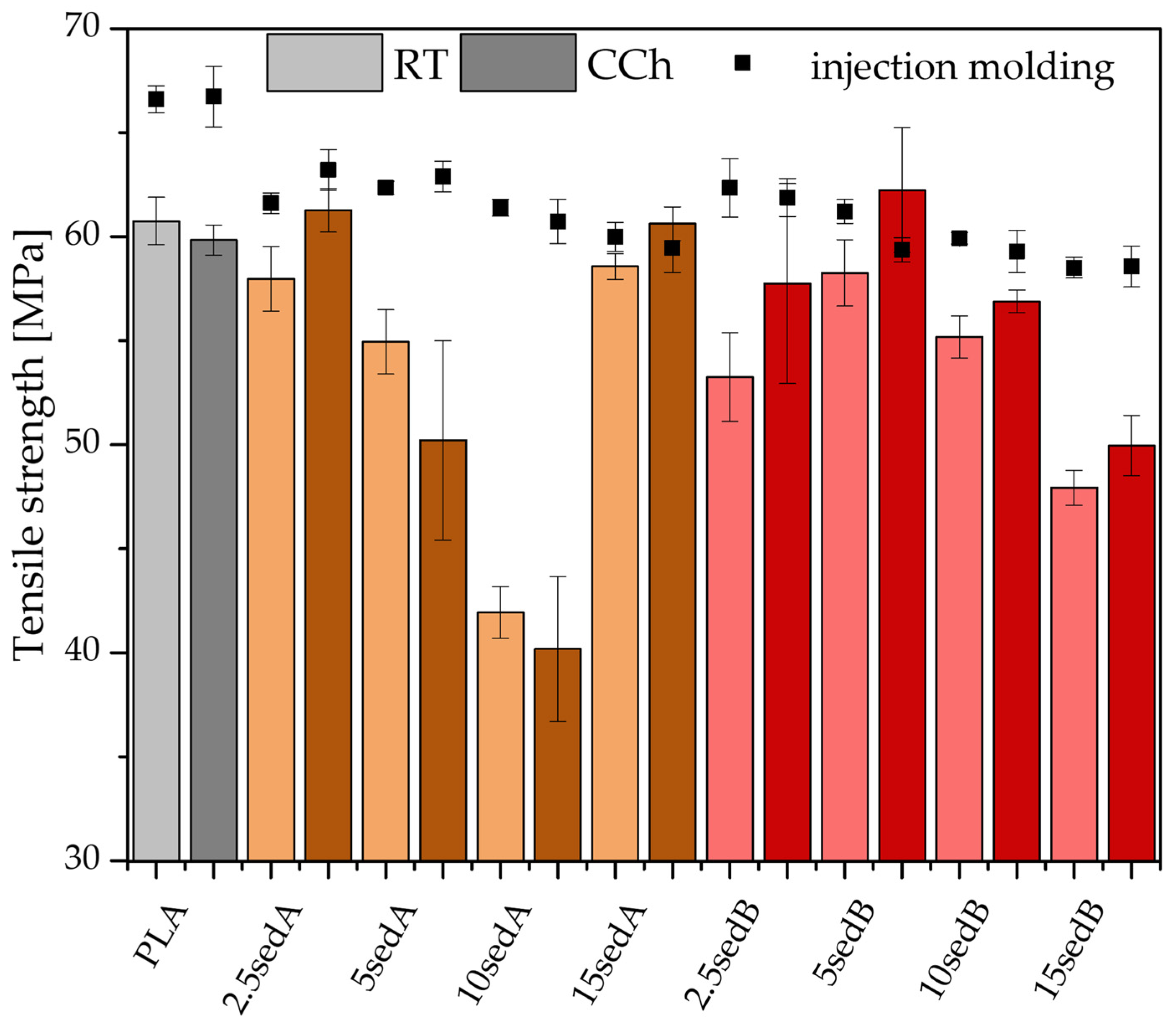
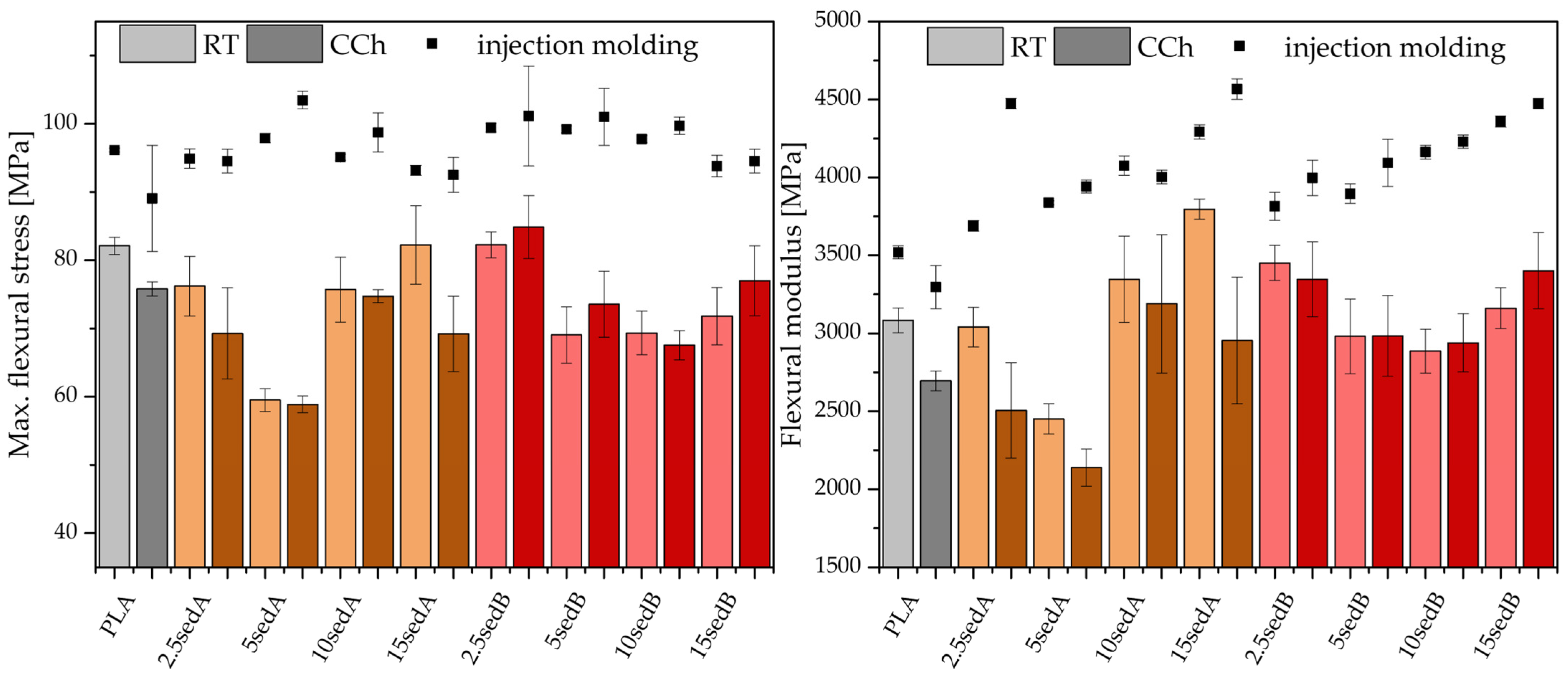
3.2. Waste Factor
3.3. Surface Properties—Contact Angle Measurements
3.4. Composite Surface Morphology—Optical and Electron Microscopy and SEM/EDS Mapping
4. Conclusions
Author Contributions
Funding
Institutional Review Board Statement
Informed Consent Statement
Data Availability Statement
Conflicts of Interest
References
- Murariu, M.; Dubois, P. PLA Composites: From Production to Properties. Adv. Drug Deliv. Rev. 2016, 107, 17–46. [Google Scholar] [CrossRef] [PubMed]
- Vink, E.T.H.; Rábago, K.R.; Glassner, D.A.; Springs, B.; O’Connor, R.P.; Kolstad, J.; Gruber, P.R. The Sustainability of NatureWorksTM Polylactide Polymers and IngeoTM Polylactide Fibers: An Update of the Future. Macromol. Biosci. 2004, 4, 551–564. [Google Scholar] [CrossRef] [PubMed]
- Castro-Aguirre, E.; Iñiguez-Franco, F.; Samsudin, H.; Fang, X.; Auras, R. Poly(Lactic Acid)—Mass Production, Processing, Industrial Applications, and End of Life. Adv. Drug Deliv. Rev. 2016, 107, 333–366. [Google Scholar] [CrossRef] [PubMed]
- Banerjee, R.; Ray, S.S. An Overview of the Recent Advances in Polylactide-based Sustainable Nanocomposites. Polym. Eng. Sci. 2021, 61, 617–649. [Google Scholar] [CrossRef]
- Dobrosielska, M.; Dobrucka, R.; Gloc, M.; Brząkalski, D.; Szymański, M.; Kurzydłowski, K.J.; Przekop, R.E. A New Method of Diatomaceous Earth Fractionation—A Bio-Raw Material Source for Epoxy-Based Composites. Materials 2021, 14, 1663. [Google Scholar] [CrossRef]
- Dobrosielska, M.; Dobrucka, R.; Brząkalski, D.; Frydrych, M.; Kozera, P.; Wieczorek, M.; Jałbrzykowski, M.; Kurzydłowski, K.J.; Przekop, R.E. Influence of Diatomaceous Earth Particle Size on Mechanical Properties of PLA/Diatomaceous Earth Composites. Materials 2022, 15, 3607. [Google Scholar] [CrossRef]
- Rafiee, K.; Kaur, G.; Brar, S.K. Recycling and Reuse Issues of PLA and PLA/Cellulose Composites. In Polylactic Acid-Based Nanocellulose and Cellulose Composites; CRC Press: Boca Raton, FL, USA, 2022; pp. 265–276. ISBN 978-1-00-316045-8. [Google Scholar]
- Vigneshwaran, K.; Venkateshwaran, N.; Selvan, S.P.; Babu, N.V.; Naresh, K. Ageing Studies of Wood-PLA 3D Printed Composites by FFF Technique. In Reference Module in Materials Science and Materials Engineering; Elsevier: Amsterdam, The Netherlands, 2022; p. B9780128203521004000. ISBN 978-0-12-803581-8. [Google Scholar]
- Kaseem, M.; Hamad, K.; Ur Rehman, Z. Review of Recent Advances in Polylactic Acid/TiO2 Composites. Materials 2019, 12, 3659. [Google Scholar] [CrossRef]
- Yu, W.; Wang, X.; Ferraris, E.; Zhang, J. Melt Crystallization of PLA/Talc in Fused Filament Fabrication. Mater. Des. 2019, 182, 108013. [Google Scholar] [CrossRef]
- Pan, H.; Wang, X.; Jia, S.; Lu, Z.; Bian, J.; Yang, H.; Han, L.; Zhang, H. Fiber-Induced Crystallization in Polymer Composites: A Comparative Study on Poly(Lactic Acid) Composites Filled with Basalt Fiber and Fiber Powder. Int. J. Biol. Macromol. 2021, 183, 45–54. [Google Scholar] [CrossRef]
- Przekop, R.E.; Kujawa, M.; Pawlak, W.; Dobrosielska, M.; Sztorch, B.; Wieleba, W. Graphite Modified Polylactide (PLA) for 3D Printed (FDM/FFF) Sliding Elements. Polymers 2020, 12, 1250. [Google Scholar] [CrossRef]
- Varga, P.; Lorinczy, D.; Toth, L.; Pentek, A.; Nyitrai, M.; Maroti, P. Novel PLA-CaCO3 Composites in Additive Manufacturing of Upper Limb Casts and Orthotics—A Feasibility Study. Mater. Res. Express 2019, 6, 045317. [Google Scholar] [CrossRef]
- Donate, R.; Monzón, M.; Alemán-Domínguez, M.E.; Ortega, Z. Enzymatic Degradation Study of PLA-Based Composite Scaffolds. Rev. Adv. Mater. Sci. 2020, 59, 170–175. [Google Scholar] [CrossRef]
- Hoque, M.E.; Ghorban Daei, J.M.; Khalid, M. Next Generation Biomimetic Bone Tissue Engineering Matrix From Poly (L- Lactic Acid) Pla/Calcium Carbonate Composites Doped With Silver Nanoparticles. Curr. Anal. Chem. 2018, 14, 268–277. [Google Scholar] [CrossRef]
- Moo-Tun, N.M.; Iñiguez-Covarrubias, G.; Valadez-Gonzalez, A. Assessing the Effect of PLA, Cellulose Microfibers and CaCO3 on the Properties of Starch-Based Foams Using a Factorial Design. Polym. Test. 2020, 86, 106482. [Google Scholar] [CrossRef]
- Pichlak, M. Gospodarka o obiegu zamkniętym–model koncepcyjny. Ekonomista 2018, 3, 335–346. [Google Scholar]
- Kulczycka, J.; Pędziwiatr, E. Gospodarka o obiegu zamkniętym—definicje i ich interpretacje. In Gospodarka o Obiegu Zamkniętym w Polityce i Badaniach Naukowych; Kulczycka, J., Ed.; Wydawnictwo IGSMiE PAN: Kraków, Poland, 2019. [Google Scholar]
- Zarębska, J. Gospodarka o obiegu zamkniętym drogą do zrównoważonego rozwoju, systemy wspomagania w inżynierii produkcji. Jakość Bezpieczeństwo Sr. 2017, 6, 286–295. [Google Scholar]
- Brząkalski, D.; Sztorch, B.; Frydrych, M.; Pakuła, D.; Dydek, K.; Kozera, R.; Boczkowska, A.; Marciniec, B.; Przekop, R.E. Limonene Derivative of Spherosilicate as a Polylactide Modifier for Applications in 3D Printing Technology. Molecules 2020, 25, 5882. [Google Scholar] [CrossRef]
- Lay, M.; Thajudin, N.L.N.; Hamid, Z.A.A.; Rusli, A.; Abdullah, M.K.; Shuib, R.K. Comparison of Physical and Mechanical Properties of PLA, ABS and Nylon 6 Fabricated Using Fused Deposition Modeling and Injection Molding. Compos. Part B Eng. 2019, 176, 107341. [Google Scholar] [CrossRef]
- Aniśko, J.; Barczewski, M. Polylactide: From Synthesis and Modification to Final Properties. Adv. Sci. Technol. Res. J. 2021, 15, 9–29. [Google Scholar] [CrossRef]
- Kaynak, C.; Varsavas, S.D. Performance Comparison of the 3D-Printed and Injection-Molded PLA and Its Elastomer Blend and Fiber Composites. J. Thermoplast. Compos. Mater. 2019, 32, 501–520. [Google Scholar] [CrossRef]
- Borkowski, G.; Martyła, A.; Dobrosielska, M.; Marciniak, P.; Gabriel, E.; Głowacka, J.; Jałbrzykowski, M.; Pakuła, D.; Przekop, R.E. Carbonate Lake Sediments in the Plastics Processing-Preliminary Polylactide Composite Case Study: Mechanical and Structural Properties. Materials 2022, 15, 6106. [Google Scholar] [CrossRef]
- Wach, R.A.; Wolszczak, P.; Adamus-Wlodarczyk, A. Enhancement of mechanical properties of FDM-PLA parts via thermal annealing. Macromol. Mater. Eng. 2018, 303, 1800169. [Google Scholar] [CrossRef]
- Huang, T.; Yamaguchi, M. Effect of cooling conditions on the mechanical properties of crystalline poly (lactic acid). J. Appl. Polym. Sci. 2017, 134, 44960. [Google Scholar] [CrossRef]
- Zhu, T.T.; Zhou, C.H.; Kabwe, F.B.; Wu, Q.Q.; Li, C.S.; Zhang, J.R. Exfoliation of montmorillonite and related properties of clay/polymer nanocomposites. Appl. Clay Sci. 2019, 169, 48–66. [Google Scholar] [CrossRef]
- Torrado, A.R.; Roberson, D.A. Failure analysis and anisotropy evaluation of 3D-printed tensile test specimens of different geometries and print raster patterns. J. Fail. Anal. Prev. 2016, 16, 154–164. [Google Scholar] [CrossRef]
- Borkowski, G.; Martyła, A.; Dobrosielska, M.; Marciniak, P.; Głowacka, J.; Pakuła, D.; Gabriel, E.; Przekop, R.E. Characterisation of carbonate lake sediments as a potential filler for polymer composites. Green Process. Synth. 2023, 12, 20228082. [Google Scholar] [CrossRef]
- Zuhaira, N.; Aziz, A.B.D.; Mohamed, R. Calcium Carbonate Composition Effect Upon Morphology, Water Absorption and Flexural. In Proceedings of the 63rd The IIER International Conference, Barcelona, Spain, 4 March 2016; pp. 20–24. [Google Scholar]
- Rafie, M.A.F.; Marsilla, K.I.K.; Hamid, Z.A.A.; Rusli, A.; Abdullah, M.K. Enhanced mechanical properties of plasticized polylactic acid filament for fused deposition modelling: Effect of in situ heat treatment MAF. Prog. Rubber Plast. Recycl. Technol. 2019, 36(2), 1–12. [Google Scholar] [CrossRef]
- Cartier, L.; Okihara, T.; Ikada, Y.; Tsuji, H.; Puiggali, J.; Lotz, B. Epitaxial crystallization and crystalline polymorphism of polylactides. Polymer 2000, 41, 89098919. [Google Scholar] [CrossRef]
- Puiggali, J.; Ikada, Y.; Tsuji, H.; Cartier, L.; Okihara, T.; Lotz, B. The frustrated structure of poly(L-lactide). Polymer 2000, 41, 8921–8930. [Google Scholar] [CrossRef]
- Kalb, B.; Pennings, A.J. General crystallization behaviour of poly(L-lactic acid). Polymer 1981, 21, 607–612. [Google Scholar] [CrossRef]
- Zirak, M.F.; Tabari, M. PLA-SiO2 nanocomposite films: Morphological and mechanical properties and specific end-use characteristics. Nanomed Res. J. 2018, 3, 140–145. [Google Scholar]
- Przekop, R.E.; Jakubowska, P.; Sztorch, B.; Kozera, R.; Dydek, K.; Jałbrzykowski, M.; Osiecki, T.; Marciniak, P.; Martyła, A.; Brząkalski, D. Opoka—Sediment Rock as New Type of Hybrid Mineral Filler for Polymer Composites. AppliedChem 2021, 1, 90–110. [Google Scholar] [CrossRef]
- Kloziński, A.; Jakubowska, P.; Przybylska, J.; Przekop, R.E. Application of in-line rheological measurements for characterization of polypropylene/opoka rock powder composites. Polimery 2019, 64, 282–289. [Google Scholar] [CrossRef]
- Jakubowska, P.; Borkowski, G.; Brząkalski, D.; Sztorch, B.; Kloziński, A.; Przekop, R.E. The Accelerated Aging Impact on Mechanical and Thermal Properties of Polypropylene Composites with Sedimentary Rock Opoka-Hybrid Natural Filler. Materials 2022, 15, 338. [Google Scholar] [CrossRef] [PubMed]
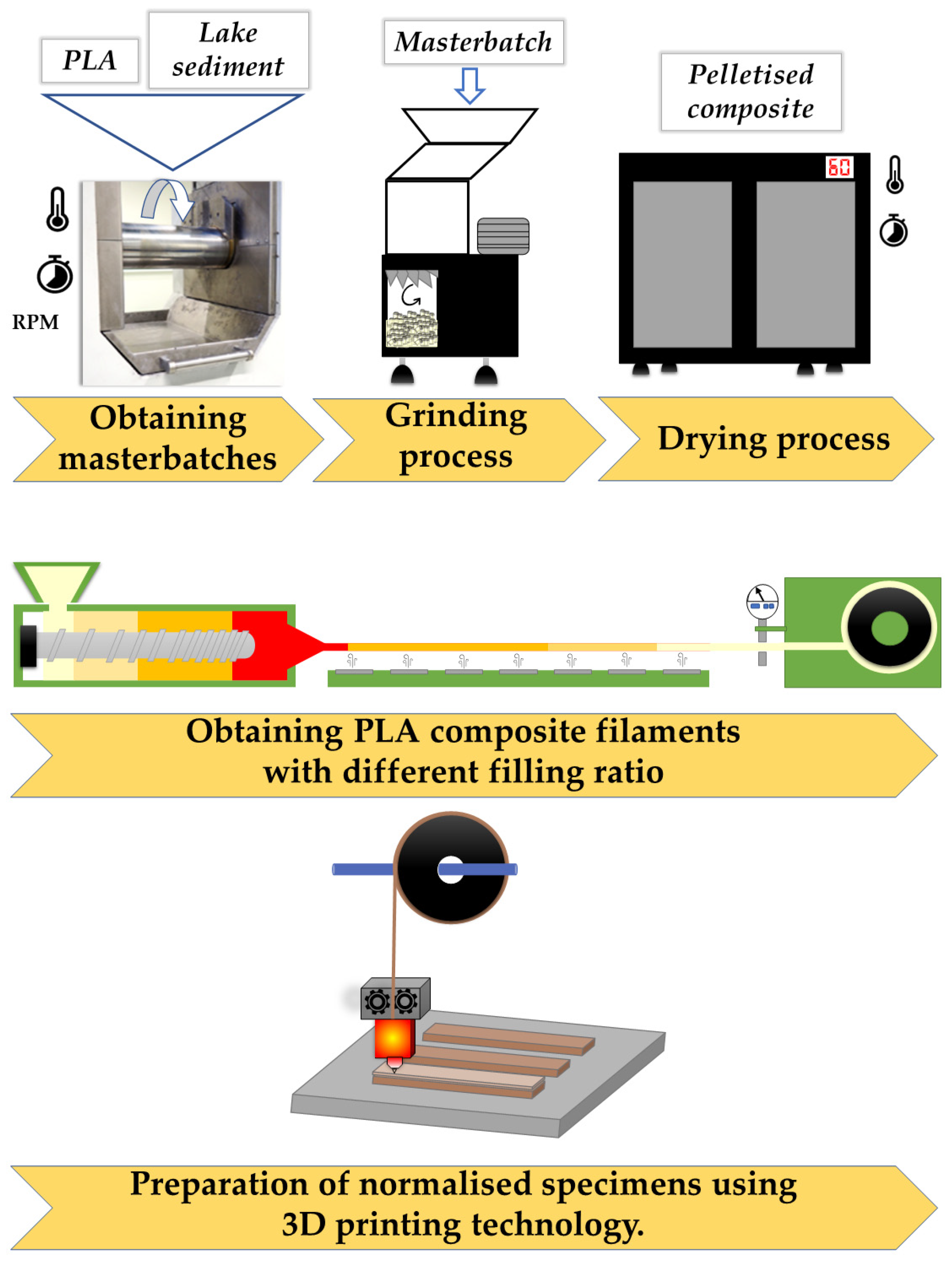
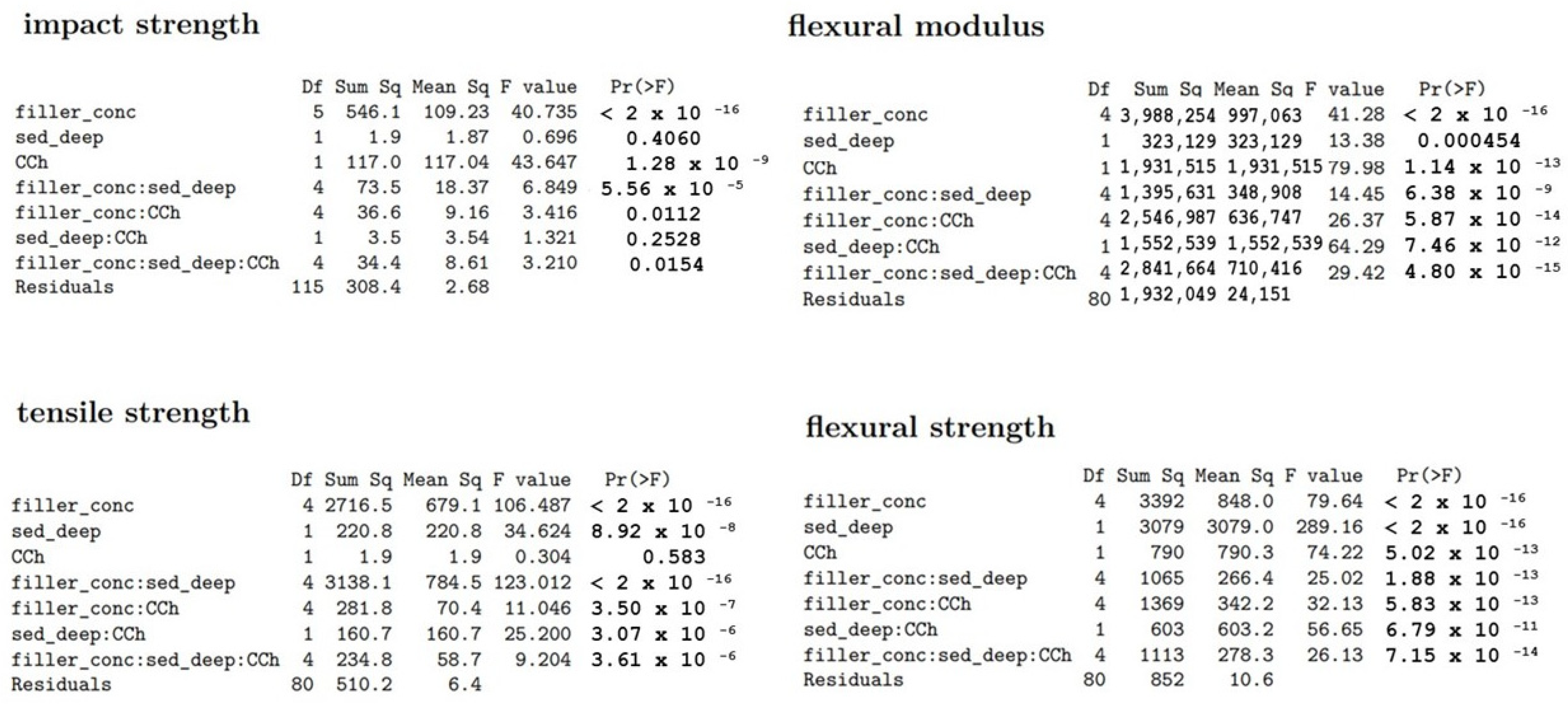
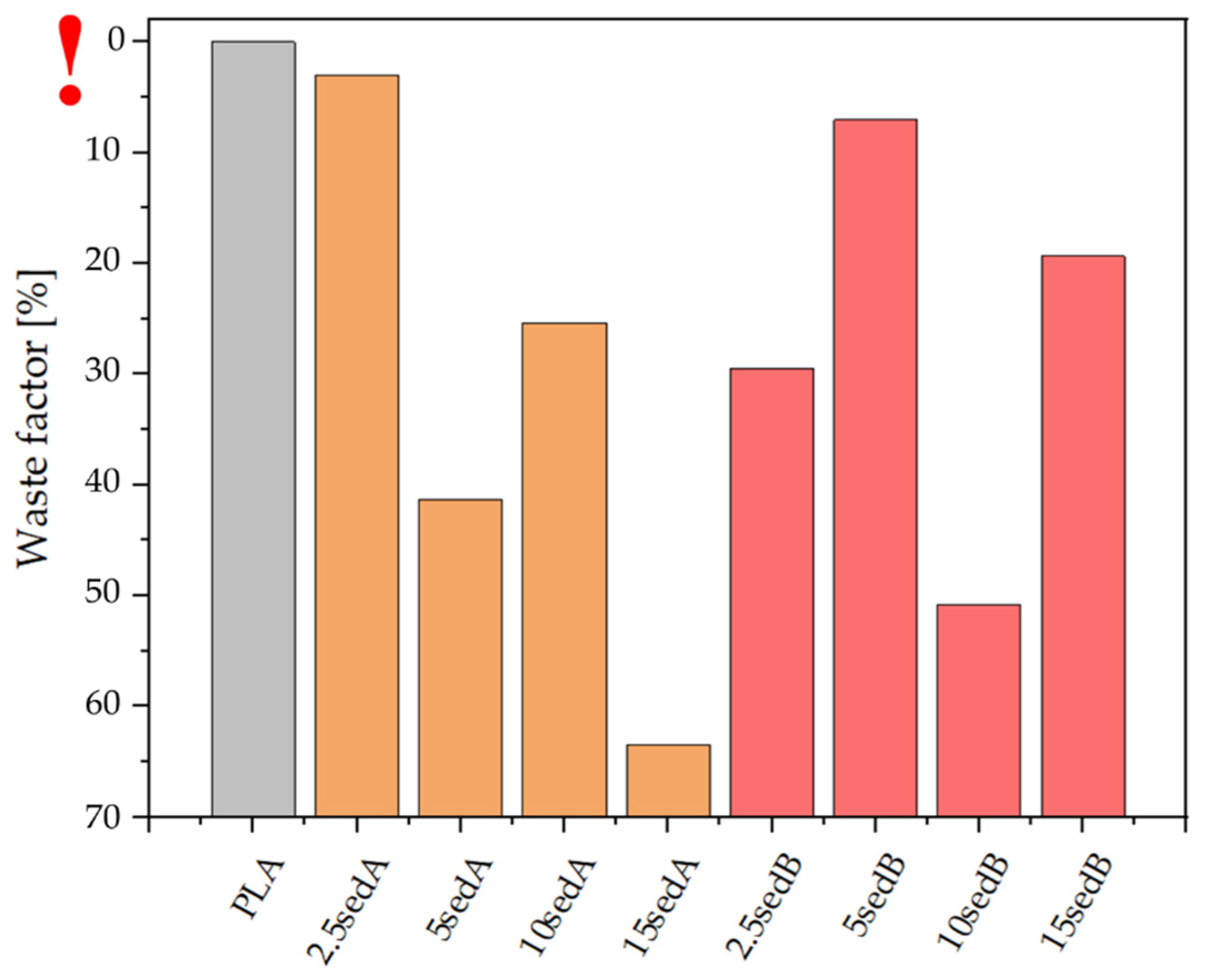


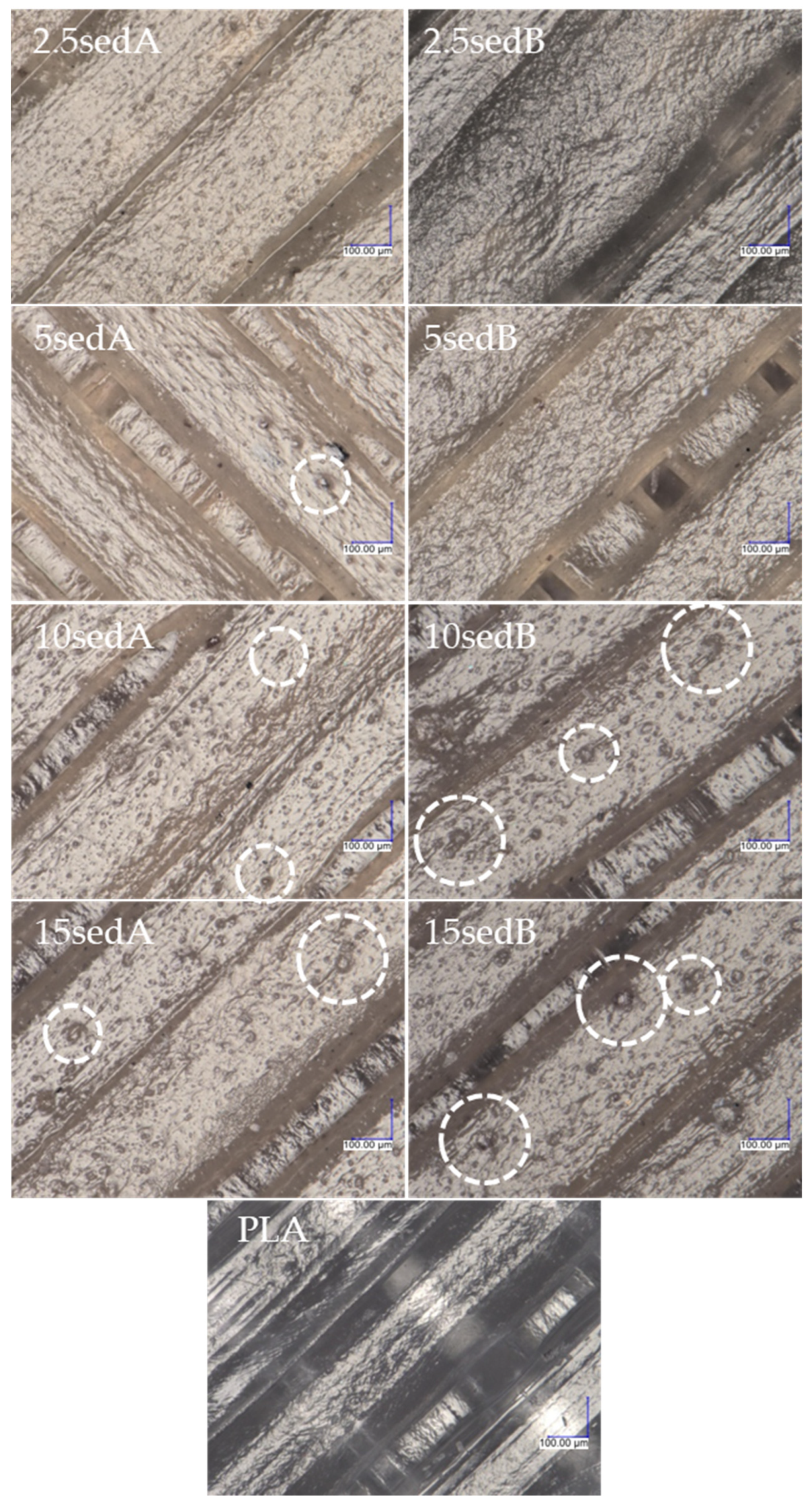

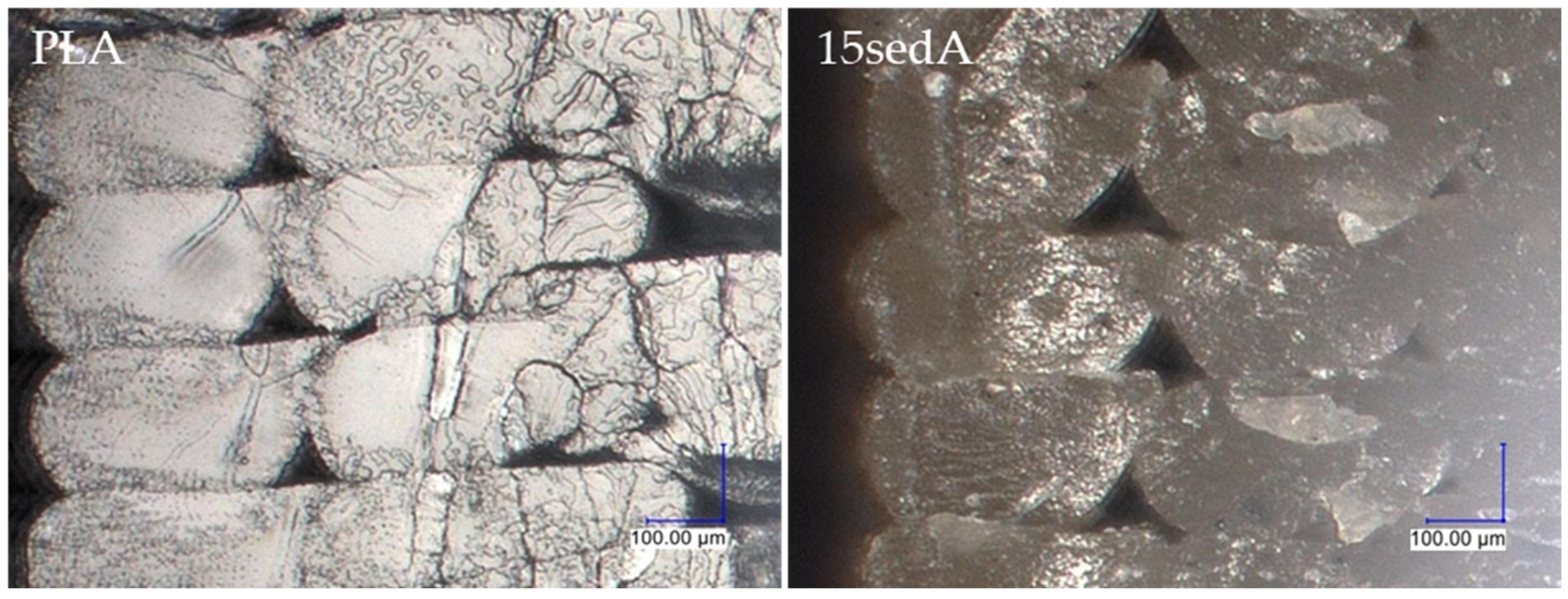

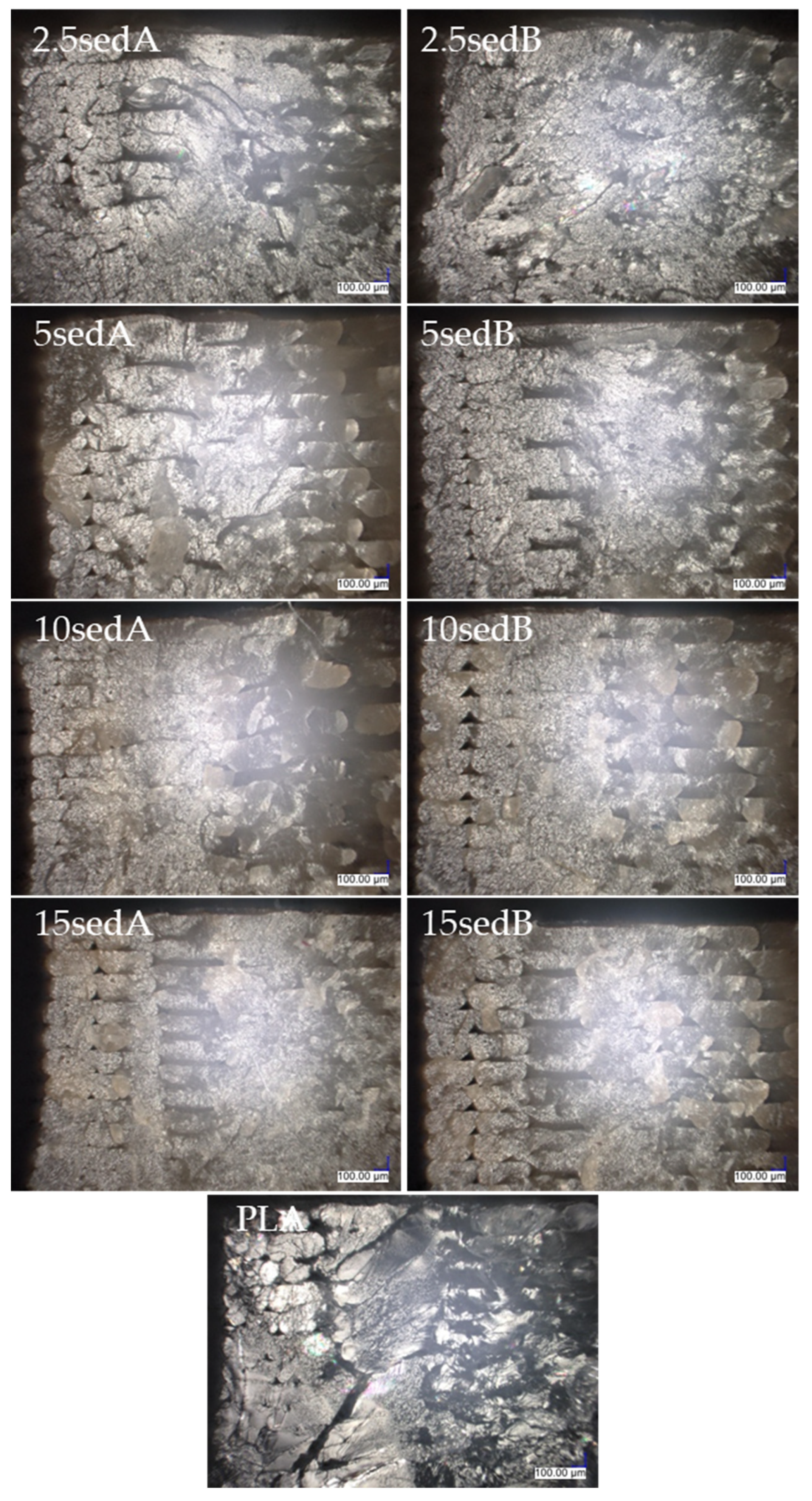
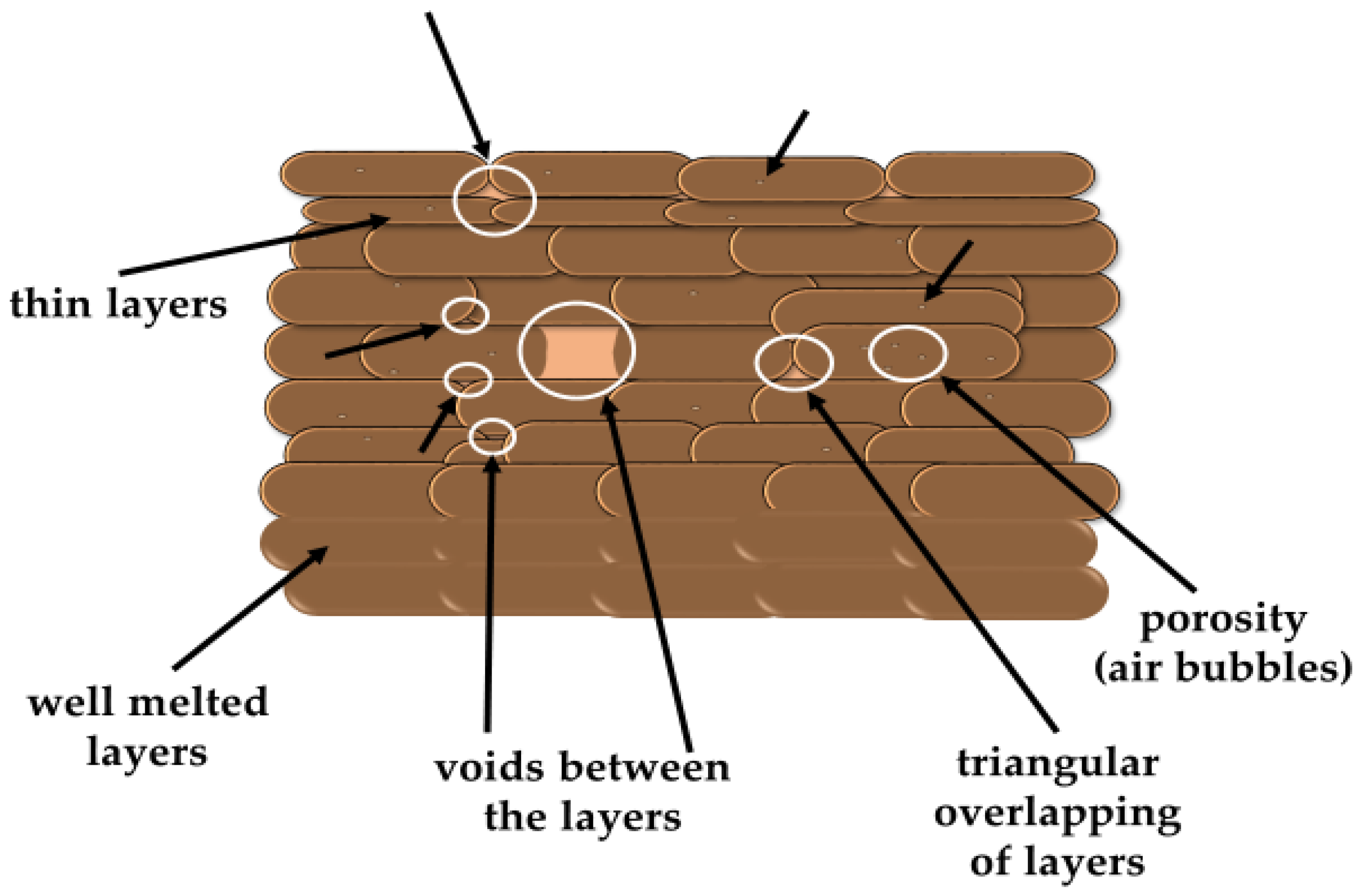
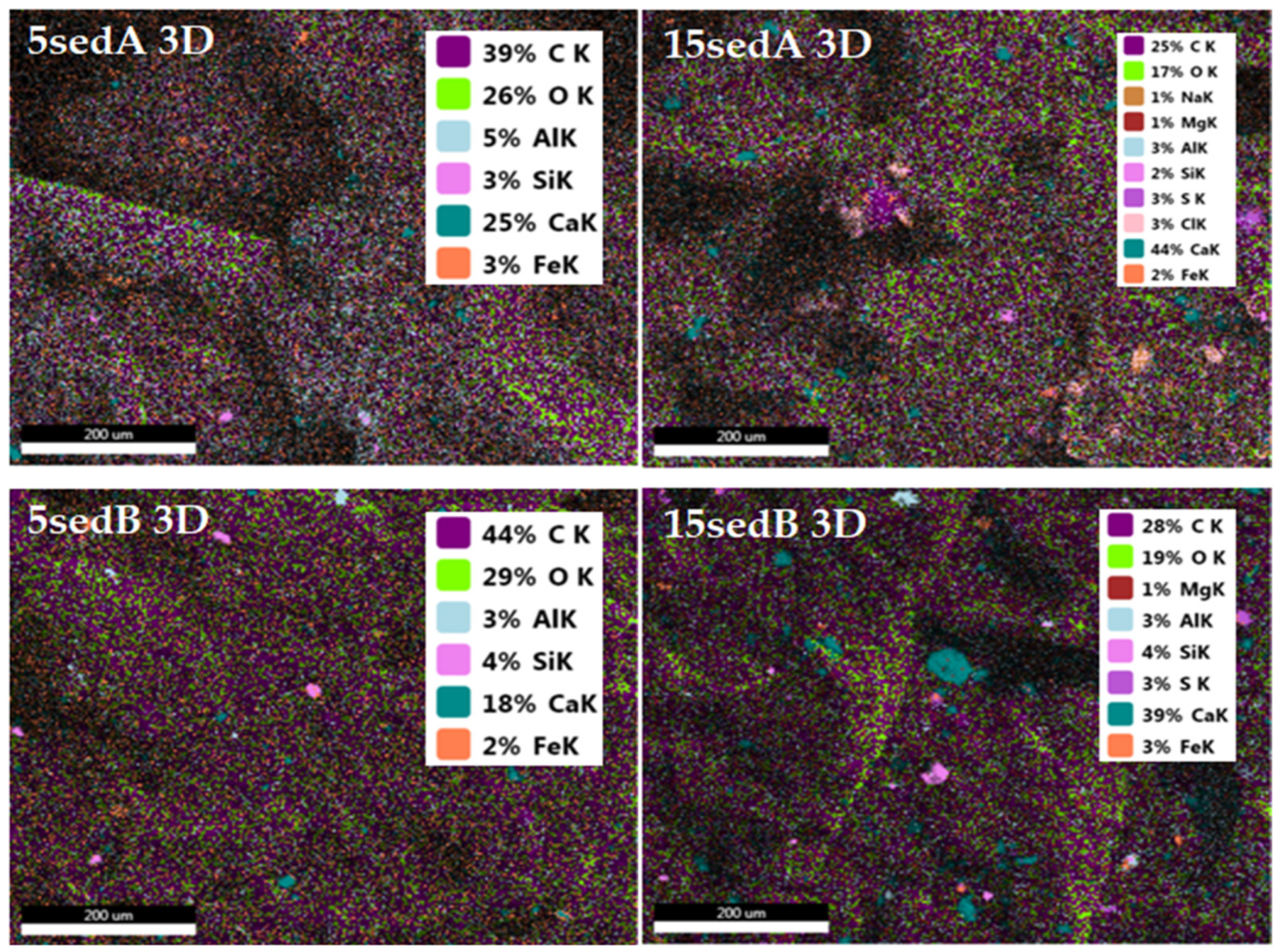

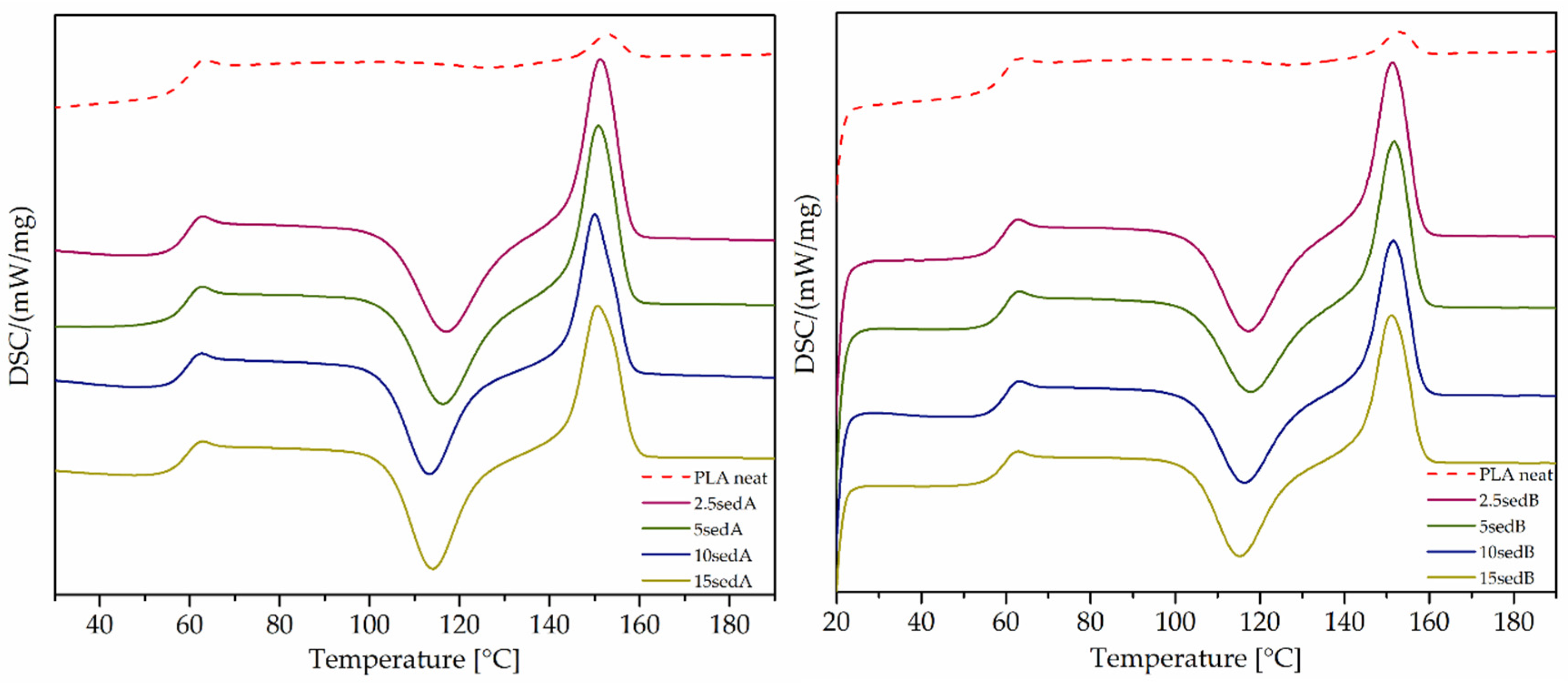
| Sample Name | Concentration of Filler (%) |
|---|---|
| 2.5sedA | 2.5, 3–8 m sediment, <40 µm |
| 5sedA | 5, 3–8 m sediment, <40 µm |
| 10sedA | 10, 3–8 m sediment, <40 µm |
| 15sedA | 15, 3–8 m sediment, <40 µm |
| 2.5sedB | 2.5, 3–8 m sediment, <40 µm |
| 5sedB | 5, 3–8 m sediment, <40 µm |
| 10sedB | 10, 3–8 m sediment, <40 µm |
| 15sedB | 15, 3–8 m sediment, <40 µm |
| Sample Name | Temperature (Die/Front/Middle/Feed) (°C) |
|---|---|
| 2.5sedA | 190/190/195/55 |
| 5sedA | 180/200/200/55 |
| 10sedA | 180/185/195/55 |
| 15sedA | 163/185/195/55 |
| 2.5sedB | 163/185/195/55 |
| 5sedB | 163/185/195/55 |
| 10sedB | 170/195/190/60 |
| 15sedB | 185/200/200/60 |
| Layer height | 0.2 mm |
| Printing speed | 60 mm/s |
| Printing speed of the 1st layer | 20 mm/s |
| Printing temperature | 210 °C |
| Bed temperature | 60 °C |
| Nozzle diameter | 0.4 mm |
| Sidewall thickness | 0.8 mm |
| Infill percentage | 100% |
| Sample | Young’s Modulus (Mpa) | Elongation at Break (%) | ||
|---|---|---|---|---|
| RT * | CCh * | RT * | CCh * | |
| Neat PLA | 3062 ± 94 | 2897 ± 94 | 2.61 ± 0.13 | 2.82 ± 0.13 |
| 2.5sedA | 3330 ± 67 | 2988 ± 65 | 2.31 ± 0.23 | 2.70 ± 0.22 |
| 5sedA | 3220± 157 | 2704 ± 212 | 2.36 ± 0.22 | 2.52 ± 0.13 |
| 10sedA | 2690 ± 52 | 2295 ± 240 | 2.10 ± 0.11 | 2.15 ± 0.25 |
| 15sedA | 3916 ± 28 | 3661 ± 96 | 2.25 ± 0.09 | 2.55 ± 0.20 |
| 2.5sedB | 3054 ± 94 | 2805 ± 289 | 2.34 ± 0.09 | 2.81 ± 0.14 |
| 5sedB | 3456 ± 68 | 3218 ± 244 | 2.27 ± 0.11 | 2.53 ± 0.24 |
| 10sedB | 3463 ± 85 | 3728 ± 131 | 2.34 ± 0.06 | 2.72 ± 0.23 |
| 15sedB | 3378 ± 30 | 3222 ± 125 | 2.05 ± 0.11 | 2.44 ± 0.18 |
| Sample | Contact Angle (°) | |
|---|---|---|
| RT * | CCh * | |
| Neat PLA | 79.2 ± 1.7 | 77.2 ± 3.4 |
| 2.5sedA | 86.4 ± 2.0 | 70.0 ± 1.8 |
| 5sedA | 77.4 ± 1.6 | 76.4 ± 3.8 |
| 10sedA | 80.2 ± 2.6 | 67.4 ± 4.8 |
| 15sedA | 86.1 ± 4.1 | 67.6 ± 5.0 |
| 2.5sedB | 80.3 ± 1.5 | 64.3 ± 3.7 |
| 5sedB | 85.9 ± 2.3 | 80.9 ± 2.3 |
| 10sedB | 73.2 ± 4.5 | 72.6 ± 3.0 |
| 15sedB | 84.0 ± 1.9 | 79.1 ± 1.5 |
| Sample Name | Fill Line 1 | Fill Line 2 |
|---|---|---|
| PLA | 396 | 365 |
| 2.5sedA | 342 | 301 |
| 5sedA | 322 | 286 |
| 10sedA | 395 | 208 |
| 15sedA | 350 | 282 |
| 2.5sedB | 497 | 192 |
| 5sedB | 333 | 315 |
| 10sedB | 277 | 278 |
| 15sedB | 378 | 332 |
Disclaimer/Publisher’s Note: The statements, opinions and data contained in all publications are solely those of the individual author(s) and contributor(s) and not of MDPI and/or the editor(s). MDPI and/or the editor(s) disclaim responsibility for any injury to people or property resulting from any ideas, methods, instructions or products referred to in the content. |
© 2023 by the authors. Licensee MDPI, Basel, Switzerland. This article is an open access article distributed under the terms and conditions of the Creative Commons Attribution (CC BY) license (https://creativecommons.org/licenses/by/4.0/).
Share and Cite
Przekop, R.E.; Gabriel, E.; Dobrosielska, M.; Martyła, A.; Jakubowska, P.; Głowacka, J.; Marciniak, P.; Pakuła, D.; Jałbrzykowski, M.; Borkowski, G. The 3D-Printed (FDM/FFF) Biocomposites Based on Polylactide and Carbonate Lake Sediments—Towards a Circular Economy. Polymers 2023, 15, 2817. https://doi.org/10.3390/polym15132817
Przekop RE, Gabriel E, Dobrosielska M, Martyła A, Jakubowska P, Głowacka J, Marciniak P, Pakuła D, Jałbrzykowski M, Borkowski G. The 3D-Printed (FDM/FFF) Biocomposites Based on Polylactide and Carbonate Lake Sediments—Towards a Circular Economy. Polymers. 2023; 15(13):2817. https://doi.org/10.3390/polym15132817
Chicago/Turabian StylePrzekop, Robert E., Ewa Gabriel, Marta Dobrosielska, Agnieszka Martyła, Paulina Jakubowska, Julia Głowacka, Piotr Marciniak, Daria Pakuła, Marek Jałbrzykowski, and Grzegorz Borkowski. 2023. "The 3D-Printed (FDM/FFF) Biocomposites Based on Polylactide and Carbonate Lake Sediments—Towards a Circular Economy" Polymers 15, no. 13: 2817. https://doi.org/10.3390/polym15132817
APA StylePrzekop, R. E., Gabriel, E., Dobrosielska, M., Martyła, A., Jakubowska, P., Głowacka, J., Marciniak, P., Pakuła, D., Jałbrzykowski, M., & Borkowski, G. (2023). The 3D-Printed (FDM/FFF) Biocomposites Based on Polylactide and Carbonate Lake Sediments—Towards a Circular Economy. Polymers, 15(13), 2817. https://doi.org/10.3390/polym15132817









